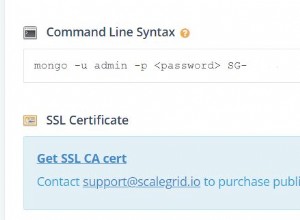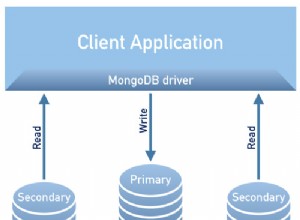Na maioria dos casos,
SADD ou ZADD com comandos de pipelining será melhor. Use uma transação MULTI/EXEC se houver risco de outro cliente obter a chave no meio, obtendo assim um objeto incompleto. Stringify a lista em um campo de hash pode ser justificável em alguns casos.
Em relação a 'Remova rapidamente as chaves', certifique-se de usar
UNLINK em vez de DEL . Se você optar por stringify, aqui está como suportar atomicamente inserir e remover em um array codificado em JSON em um campo de hash usando a biblioteca Lua e Lua CJSON:
Inserir :
local items = cjson.decode(redis.call('HGET', KEYS[1], 'items'))
table.insert(items, ARGV[1])
return redis.call('HSET', KEYS[1], 'items', cjson.encode(items))
Remover por valor :
local items = cjson.decode(redis.call('HGET', KEYS[1], 'items'))
local pos = -1;
for i, v in ipairs(items) do
if ARGV[1] == v then
pos = i
break
end
end
if pos == -1 then
return -1
else
table.remove(items, pos)
return redis.call('HSET', KEYS[1], 'items', cjson.encode(items))
end
Exemplo de uso :
> HGETALL meta_key
1) "user"
2) "12345"
3) "tag"
4) "D12321341234123"
5) "items"
6) "{}"
> EVAL "local items = cjson.decode(redis.call('HGET', KEYS[1], 'items')) \n table.insert(items, ARGV[1]) \n return redis.call('HSET', KEYS[1], 'items', cjson.encode(items))" 1 meta_key value1
(integer) 0
> HGETALL meta_key
1) "user"
2) "12345"
3) "tag"
4) "D12321341234123"
5) "items"
6) "[\"value1\"]"
> EVAL "local items = cjson.decode(redis.call('HGET', KEYS[1], 'items')) \n table.insert(items, ARGV[1]) \n return redis.call('HSET', KEYS[1], 'items', cjson.encode(items))" 1 meta_key value2
(integer) 0
> HGETALL meta_key
1) "user"
2) "12345"
3) "tag"
4) "D12321341234123"
5) "items"
6) "[\"value1\",\"value2\"]"
> EVAL "local items = cjson.decode(redis.call('HGET', KEYS[1], 'items')) \n local pos = -1; \n for i, v in ipairs(items) do \n if ARGV[1] == v then \n pos = i \n break \n end \n end \n if pos == -1 then \n return -1 \n else \n table.remove(items, pos) \n return redis.call('HSET', KEYS[1], 'items', cjson.encode(items)) \n end" 1 meta_key value1
(integer) 0
> HGETALL meta_key
1) "user"
2) "12345"
3) "tag"
4) "D12321341234123"
5) "items"
6) "[\"value2\"]"
> EVAL "local items = cjson.decode(redis.call('HGET', KEYS[1], 'items')) \n local pos = -1; \n for i, v in ipairs(items) do \n if ARGV[1] == v then \n pos = i \n break \n end \n end \n if pos == -1 then \n return -1 \n else \n table.remove(items, pos) \n return redis.call('HSET', KEYS[1], 'items', cjson.encode(items)) \n end" 1 meta_key value3
(integer) -1
> HGETALL meta_key
1) "user"
2) "12345"
3) "tag"
4) "D12321341234123"
5) "items"
6) "[\"value2\"]"




